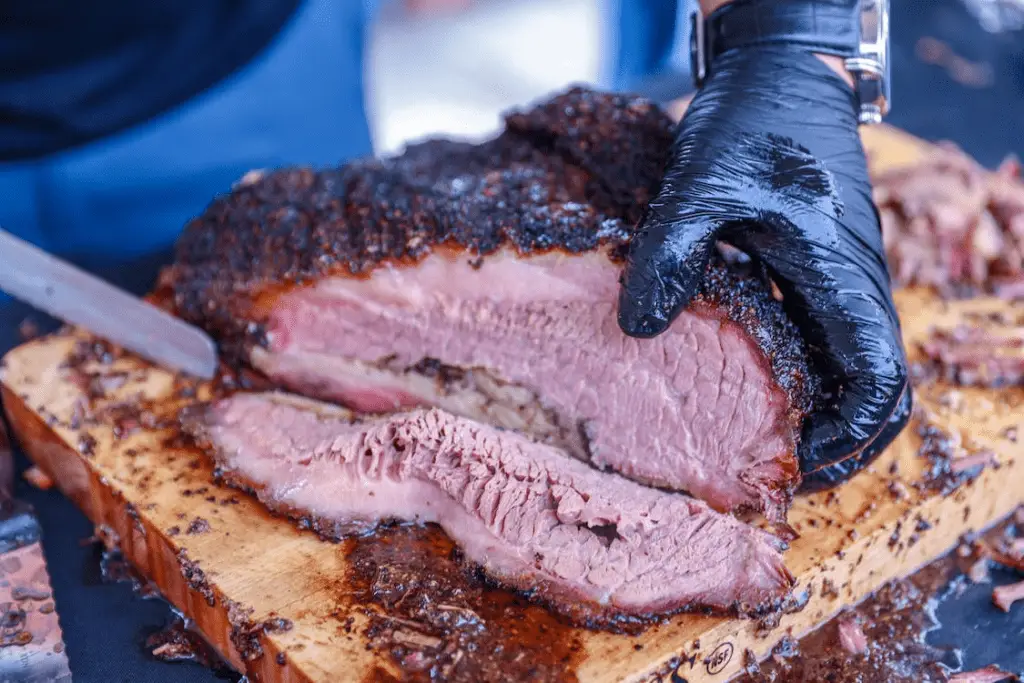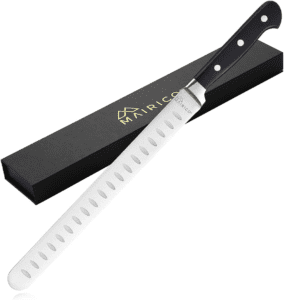Share via:
As a pit master, you might already have learned by now that brisket is the toughest cut of meat to cook. Our research has uncovered important information like brisket internal temperature as well as brisket stall temperature.

However, it is also important to know what temp to serve brisket after resting. It might be one of the most important phases of enhanced flavor, tenderness, and juiciness of the meat.
Let’s discuss the optimal serving temp for brisket. We will find that the brisket is pulled at 204 F when it is wrapped in foil and continues to cook till it reaches 210 F. Rest the brisker for a further 2-3 hours and unwrap it when the internal temperature reaches 150 to 170 F. The latter is the best serving temp for brisket for a delicious and tender brisket cut.
In a previous article, I shared the Guide to Smoked Brisket Internal Temp which is an important piece of information to understand before we move on to finding out the accurate temperature for serving and eating brisket.
The Safe Temperature For Eating Brisket
Most meat is safe to eat when it reaches an internal temperature of 140 F, however, at 140, brisket starts to breed bacteria due to the moisture.
Hence, pit masters swear to pass by this temp as quickly as possible and try to hit the 170 F mark as early as possible (within four hours).
The final brisket internal temp is anywhere between 190 F to 210 F for a safe and tender meat cut. Cooking brisket requires experience and a pitmaster is one who has learned to cook this cut with much trial and error.
Best Serving Temp For Brisket: What Temp to Serve Brisket after Resting
What temperature to pull brisket?
To pull or shred a brisket for serving, the recommended internal temperature of the meat should be in the range of 195-205°F (90-96°C). Pulling brisket at this temperature ensures that it is tender and easy to shred into flavorful, bite-sized pieces.
Here’s how to do it:
1- Cook Brisket to 195-205°F:
Begin by cooking your brisket to an internal temperature of 195-205°F (90-96°C). This temperature range allows the collagen and connective tissues in the meat to break down fully, resulting in a tender and juicy brisket.
2- Use a Probe Thermometer:
Use a probe meat thermometer to monitor the internal temperature. Insert the thermometer into the thickest part of the brisket, avoiding contact with the bone if applicable.
3- Check for Tenderness:
The meat should feel tender when probed, and the thermometer should slide in easily without resistance. If you encounter any tough spots or resistance, the brisket may need more time to cook.
4- Rest the Brisket:
Once the brisket reaches the desired internal temperature and tenderness, remove it from the heat source and let it rest for about 30 minutes to allow the juices to redistribute.
5- Shred or Pull:
Slicing is the most essential step in this whole process as it has a massive effect on the brisket’s taste. After resting, brisket should be served and sliced when its internal temperature comes down to anywhere between 150 F to 170 F.
After the resting period, use two forks or meat shredding claws to shred or pull the brisket apart. The meat should easily fall apart into tender, flavorful pieces.
The 195-205°F (90-96°C) range is considered optimal for pulled or shredded brisket. Keep in mind that the exact internal temperature at which your brisket becomes tender may vary slightly depending on factors such as the size of the brisket, the cooking method, and the specific characteristics of the meat. Monitoring tenderness by feel is just as important as relying on the thermometer
Can you eat brisket at 150/165/190?
The optimal brisket temperature for slicing is between 150 to 170 F. Going higher than 170 will make your brisket run dry.
If you slice the meat at a brisket serving temp of 190 F, you risk losing its juiciness and making it go dry as it cools down further.
Going lower than the serving temperature for brisket might probably give you cold and hard brisket meat, which is also unsafe to eat.
Difference Between Brisket Finishing Temperature and Brisket Serving Temperatures

Now, before we get confused, let’s understand the difference between brisket serving and finishing temperatures.
The brisket finishing temperature is the point where you stop cooking this meat and pull it off the smoker. As mentioned, that temperature is between 190 F to 210 F.
Professional pit masters pull at 205 F and hold it till the internal temp reaches 210 F.
But when it comes to at what temperature to serve brisket? That’s a whole different ball game.
There is a resting period between the two temps which we will discuss below.
Optimal Temperature and Duration for Resting Brisket
Why resting brisket is important?
Resting brisket basically means letting it sit, all wrapped in foil, and rest at room temperature for it to continue cooking for at least 2 to 4 hours.
Brisket temp reaches 210 F within the first hour of the resting period, which is an essential ground to cover. When brisket is cooked, it loses a lot of moisture, especially during the high and fast brisket cooking method.
Resting helps this cut in reversing that and resealing some juices within the meat’s fibers to make them tender and juicy. If you slice the brisket without letting it rest, the brisket will be bone dry internally as well as lose all its remaining moisture out there on your carving plate.
The resting period is when brisket redistributes all its juiciness across its fibers. Resting is an essential part of the smoking brisket process.
What temp to rest brisket at? If that’s your next question, then you need to understand the process of ‘carryover cooking.’ Meat keeps cooking for one hour even after you pull it off the smoker due to the high temperatures.
So, when the brisket reaches an internal temp of 200-204 F, it’s best to pull it, wrap it, and let the brisket rest for an hour at that point till it reaches 210 F.
Cooking it till 210 F and pulling afterward will only make the meat dry and resting is an important step for letting brisket regain its moisture and juices.
Now you may be asking how long to rest brisket? Brisket is actually rested for around 2-4 hours, however, it reaches optimal internal temp after the first hour.
Resting Brisket For 12 hours
Now if you are an early bird like me, you might want to cook 12 hours or a day early for that juicy and flavorful brisket served to your guests right on time.
Never slice it after the above mentioned one hour mark, if that’s the case. Refrigerate the brisket wrapped in one whole piece to retain its flavors and juice.
In this way, you can easily reheat it and never lose any of its moisture. Give yourself a window of two hours if you are going to reheat.
How to Wrap and Store Brisket?
If you plan to refrigerate the brisket before serving, then remember to wrap it up in foil and store it on a lower, closed shelf of your refrigerator.
Crank up your oven to 300 F and put your wrapped-up whole brisket in it. Heat it up until the temperature reaches the optimal brisket serving temp which is between 140 F to 150 F.
Take it out of the oven, wait for 5-10 minutes, and then slice it like it’s fresh out of a smoker!
Don’t just unwrap right out of the oven. Take it out of the oven only when the internal brisket serving temp reaches anywhere between 140 F to 150 F.
Let it rest all wrapped up till the internal temp reaches anywhere between 150 F to 170 F. Unwrap the brisket at that point and slice for a flavorful and juicy brisket dish.
Why Wrap Brisket?
Wrapping brisket after it’s cooked ensures that the juices don’t run out of the meat and are not lost. The wrap holds the juices together while you refrigerate it, reheat, and slice it later.
Butcher paper and foil have been found to be the best wrapping materials for this purpose.
Brisket Temperature for Slicing
Only slice brisket, whether you rest it or not, at an internal brisket serving temp of 150 F to 170 F.
You can hold it in a cooler, warming cabinet, or smoker to maintain this temperature if there is still time to serve.
But the important tip is to ONLY SLICE WHEN IT IS TIME TO SERVE! Slicing brisket means the juices flow out and if not eaten right away, it can lose all moisture and dry up.
Not only that but also remember to slice as much brisket as is needed and keep the remaining intact for storing up and reheating with its juices later.

How to slice brisket?
I am a writer, editor, and publisher of Grillcuisines.com – an online blog dedicated to sharing grilling tips, accessories, and recipes to encourage more people to get outside and grill.
I’m off to find out the different types of grill foods, their seasons, and how to conduct outdoor cooking properly. I’ll also show you some of my grill-worthy cooking tools & accessories!

